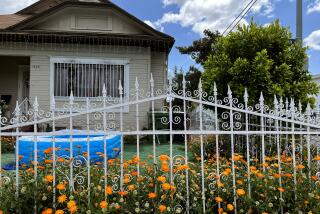Bye-Bye, Bungalow
Some pieces of architecture are born symbolic, some achieve symbolism, and others--well, others wind up on the side of a highway in the middle of Los Angeles.
That was the modified Shakespearean phrase that came to mind as I watched the unfolding drama surrounding the so-called Freeway House. The single-story structure had been on its way from Santa Monica to Santa Clarita a few weeks ago, riding atop a trailer, when it smashed into an overpass and came to rest on the shoulder of the 101 in the Cahuenga Pass.
It was no architectural gem; small-boned and modest, it seemed, vaguely, to be a descendant of both the ranch house and the bungalow. But it had a vulnerable charm. I can’t have been the only one who made repeat visits to check on it. I headed north on the 101 on several afternoons--sort of a working lunch--to drive by, to rubberneck, to see if the house was still there.
It was. It stayed in the news for days--traffic reporters joked about it, blogs showed photographs of it from every angle--and yet Caltrans and city officials couldn’t get it together to haul the thing away. Seeing it through the windshield was a little unsettling. I’d expected the architectural version of voyeurism. But voyeurism relies on a certain veil of privacy. This house was exposed to an embarrassing degree.
Soon it sprouted graffiti. Then the graffiti spread, covering the house like a fungus. Orange traffic cones were arranged around it, then rearranged, then rearranged again.
Some symbolic storylines write themselves. In post-Katrina New Orleans, where I spent a week reporting in the days just after the storm, the number of dead bodies languishing quite visibly in the late-summer heat were clear signs of the government’s now infamously sluggish response to the hurricane and the way it preyed on the weak and solitary.
So what did the similarly abandoned Freeway House symbolize? For me, the message changed as its stay on the shoulder continued. In the first couple of days, it was a curiosity, a classic fish-out-of-water tale. Like any news consumer, I considered its fate in literal terms: There is a house --a house!--sitting on the 101. You see that picture in the paper, you look at it. But as a few days stretched past a week, the house’s nakedness and vulnerability--the way it couldn’t escape the glare of eyes and headlights as it waited in vain for rescue--began to give the story a larger meaning, one connected to the way Los Angeles is shedding, or being forced to shed, its sense of privacy.
For most of its existence Los Angeles has offered its residents, and its buildings, a remarkable number of ways to shield themselves from full exposure. Nearly all of our architectural landmarks are not just private houses but hidden, shrouded, screened or inward-looking ones. If you drive by the Eames House, the Schindler House or Frank Lloyd Wright’s La Miniatura, mostly what you see is a hedge or a wall of bamboo.
Many of our famed public buildings share the same posture. The iconic view of Dodger Stadium doesn’t even include the stadium itself. It is the row of palm trees silhouetted against the sky that, for anybody who knows L.A. geography, marks the hidden presence of the stadium tucked below in Chavez Ravine. In architectural, civic and pop psychology terms, the enduring richness of L.A. has been its interiority.
But that’s changing. Along Grand Avenue and elsewhere, we are trying to build new landmarks that connect more fluidly and openly to the sidewalk and the street. And about 95% of the residential units built in the city last year were condos and apartments, which lack the buffer of landscaping that gives so many houses here a remarkable sense of isolation. Still, the thousands of single-family residences that exist within the city limits are going to be with us for some time. We are going to have to deal with them the way people deal with aging relatives. How we treat them will be a test of our forbearance and imagination.
That made the Freeway House’s purgatory seem all the crueler. It also made its destination entirely appropriate. After 11 days, Caltrans finally hauled it away. Local news crews followed it via helicopter on its journey north--the white Bronco meets “This Old House.” Later, a reporter for the Valley News tracked it down in Canyon Country, sitting behind a chain-link fence with other large-scale freeway detritus.
The images of its cramped new quarters were nearly as powerful as the ones taken while it sat on the 101. It became clear where the Freeway House had wound up--in the architectural version of a nursing home. I’m already feeling guilty for not having paid a visit.
More to Read
Sign up for Essential California
The most important California stories and recommendations in your inbox every morning.
You may occasionally receive promotional content from the Los Angeles Times.











